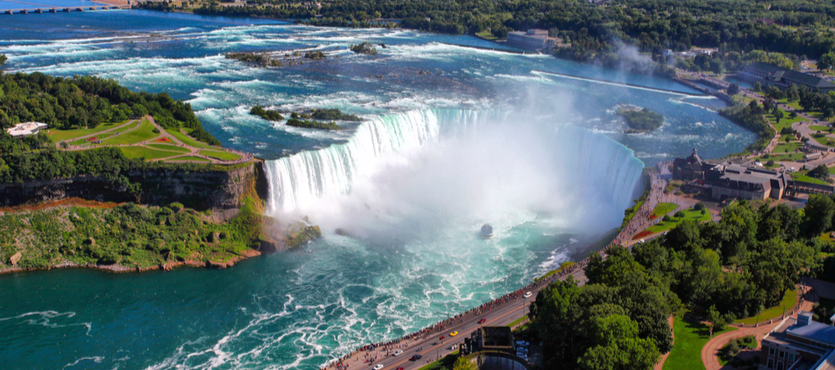As the second largest waterfall in the world, Niagara Falls is a sight to be seen. There are three different Falls that make up the classic U-shape that formed over 12,000 years ago when the ice age came to an end.
As all of the ice melted, it began to form huge torrents of water that drained into the Niagara River and surged over the edge of the Niagara Escarpment. Over time, the never-ending streams of water wore down layers of rock and caused Niagara Falls to move upstream, where its current location exists.
To this day, the cycle continues with water freezing in the winter and then melting into a waterfall come spring. We continue to see gradual erosion of the waterfall cliffs and periodically rocks will fall as a result.
Experts have completed remedial work on the Falls to better preserve it. In addition, the quantity of water is reduced and used to create hydroelectric power, this further slows down deterioration while putting the water to good use.
Who Were the First People to Witness the Beauty of Niagara Falls?
It is believed that Native Americans were the first individuals to see the breathtaking beauty of the Falls.
In December 1678, French explorer Father Louis Hennepin discovered Niagara Falls. Soon thereafter, the region transformed into a French stronghold with forts popping up all along the mouth of the Niagara River, and the French controlling access to the Great Lakes.
You can still see a restored fort today, known as Old Fort Niagara, where they put on live reenactments and demonstrations throughout the year.
Is Niagara Falls Natural or Manmade?
Niagara Falls formed naturally but there are some manmade elements to it nowadays. The beautiful natural wonder spans the American and Canadian border and has wowed visitors since the 1820s. Hence, why it was named the New 8th Wonder of the World.
Mankind has played a role in modern day Niagara Falls because the amount of water allowed to spill over the Falls is reduced, with some of it going towards the creation of hydroelectric power. This also reduces the rate of erosion.
In 1896, Nikola Tesla invented an alternating current system that allowed the power of Niagara’s water to generate power for local homes and businesses. You can find the Niagara Gorge Discovery Center right above the site of the Schoellkopf Power Station, the original spot where electricity was bought and sold as a commodity.
Power plants are now located on both the American and Canadian side of the Falls, producing a combined 2.5 million kilowatts of electricity.
Will Niagara Falls Ever Dry Up?
So much water is constantly pouring over Niagara Falls, so it’s hard to imagine it will continue forever. Instead of drying up, all of this water will eventually erode away the cliffs, so that the water disappears into Lake Erie.
The massive flood of water pouring over the rocks causes erosion at the base of the cliff, as a result the cliff has moved further back over time. Eventually, the existing cliff face will completely collapse, and the new edge will move upstream. This will at some point push Niagara Falls into Lake Erie, where it will disappear.
The rate of erosion changes based on how much water falls over the cliff, at what speed it moves at, and the type of rocks that make up the cliff.
Before you panic, at the rate that the cliffs are currently eroding, it will be about 23,000 years before they disappear. Keep in mind, the Falls have only existed for about half of that time – 12,000 years.
In 1960, one of the three waterfalls did nearly dry up, producing nothing more than a trickle of water. Experts dug into the matter and discovered that the cause was related to rockslides that were blocking the water.
Come Explore Niagara Falls
Campark welcomes you to come explore the beauty of Niagara Falls, along with the natural wonders the surrounding area has to offer. We offer tent camping, RV camping, and cabins for rent.


